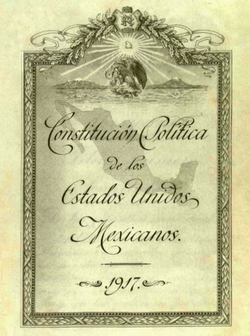The current Constitution of Mexico, formally the Political Constitution of the United Mexican States (Spanish: Constitución Política de los Estados Unidos Mexicanos), was drafted in Santiago de Querétaro, in the State of Querétaro, Mexico, by a constituent convention during the Mexican Revolution. It was approved by the Constituent Congress on 5 February 1917, and was later amended several times. It is the successor to the Constitution of 1857, and earlier Mexican constitutions. "The Constitution of 1917 is the legal triumph of the Mexican Revolution. To some it is the revolution."[1]
The current Constitution of 1917 is the first such document in the world to set out social rights, serving as a model for the Weimar Constitution of 1919 and the Russian Soviet Federative Socialist Republic Constitution of 1918.[2][3][4][5] Some of the most important provisions are Articles 3, 27, and 123; adopted in response to the armed insurrection of popular classes during the Mexican Revolution, these articles display profound changes in Mexican politics that helped frame the political and social backdrop for Mexico in the twentieth century.[6] Article 3 established the basis for free, mandatory, and secular education;[7][8] Article 27 laid the foundation for land reform in Mexico;[8] and Article 123 was designed to empower the labor sector, which had emerged in the late nineteenth century and which supported the winning faction of the Mexican Revolution.[8]
Articles 3, 5, 24, 27, and 130 seriously restricted the Roman Catholic Church in Mexico,[9] and attempts to enforce the articles strictly by President Plutarco Calles (1924–1928) in 1926 led to the violent conflict known as the Cristero War.[9]
In 1992, under the administration of Carlos Salinas de Gortari, there were significant revisions of the constitution, modifying Article 27 to strengthen private property rights, allow privatization of ejidos and end redistribution of land, and the articles restricting the Roman Catholic Church in Mexico were largely repealed.[10][11][12][13][14]
Constitution Day (Día de la Constitución) is one of Mexico's annual Fiestas Patrias (public holidays), commemorating the promulgation of the Constitution on 5 February 1917. The holiday is held on the first Monday of February.[15]
The constitution was founded on seven fundamental ideals:

The Constitution is divided into "Titles" (Títulos) which are series of articles related to the same overall theme. The Titles, of variable length, are:
First Title:
Second Title:
Third Title:
Fourth Title:
Fifth Title:
Sixth Title:
Seventh Title:
Eighth Title
Ninth Title:

The Political Constitution of the United Mexican States is one of the major outcomes of the Mexican Revolution that started in 1910 and won by the Constitutionalist faction led by Venustiano Carranza. Carranza's Constitutionalist coalition invoked the liberal 1857 Constitution to unite Mexicans against the regime of General Victoriano Huerta, who had come to power by a coup in February 1913. The revolutionaries fought for causes that were beyond the political bounds of the 1857 Constitution. Various political plans articulated demands for socio-economic reform. Carranza's Constitutionalist faction emerged victorious in 1915, having defeated Huerta's regime and then the bloody civil war between the revolutionary faction of Pancho Villa and Emiliano Zapata. Historian Alan Knight contends that the new constitution was "a means to confer legitimacy on a shaky regime."[17]
Carranza initially envisioned revisions to the 1857 Constitution that would incorporate the demands for which revolutionaries fought. Carranza's 1913 Plan of Guadalupe and its subsequent updates did not include demands for a new constitution, but his advisors persuaded him that the best way forward was a new constitution rather than a piecemeal revision of the earlier Constitution. He had initially floated the idea of a constitutional convention in September 1913, but had not pursued the idea in the thick of revolutionary struggle, but once he had consolidated power, he formally and publicly articulated the idea. Writing in February 1915, he stated "When peace is established, I shall convoke a Congress duly elected by all people which shall have the character of a congreso constituyente for raising constitutional precepts the reforms dictated during the struggle."[18] Félix Palavicini persuaded Carranza that a new constitution was the best way to return to rule of law, through a new governing document. Carranza agreed, allowing Palavicini to launch a press campaign to win over Mexicans, and especially the revolutionary army generals, to the idea.[19]
Palavicini argued that incorporating revolutionary reforms into a new constitution would give them firm standing in the present and future that could be overturned easily. Once a new legislature was convened, legislators could more effect reforms efficiently since they were part of the constitution already. The Constitution of 1857 had subordinated the executive branch to the legislative, in an attempt to curtail the power of strong presidents. The liberal general Porfirio Díaz when president for more than three decades made the legislature and the courts subordinate to his executive power while the Constitution of 1857 remained in effect in theory, but not in practice. Palavicini argued that the process of amending the constitution would be time-consuming and piecemeal. Since the multiple major revolutionary reforms were not part of the 1857 Constitution, adding them would entail further complexity. A new constitution drafted by elected delegates would give legitimacy to the new charter, arguing for a constituent congress. Although there was some resistance to the idea, the revolutionaries recognized the "right of revolution", that having won the conflict, the victors could have their way in creating the new document.[20]
.jpg/440px-Patrons_outside_the_Theater_of_Queretaro,_Mexico,_ca.1905-1910_(CHS-648).jpg)